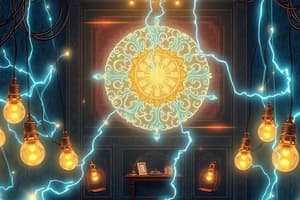Podcast
Questions and Answers
What happens to electric current when one element of the circuit is not in firm electrical contact?
What happens to electric current when one element of the circuit is not in firm electrical contact?
- The electric current stops, creating an open circuit. (correct)
- The circuit becomes a short circuit.
- The current flows in reverse direction.
- The current continues to flow without interruption.
Which of the following materials is a good conductor of electricity?
Which of the following materials is a good conductor of electricity?
- Rubber
- Copper (correct)
- Wood
- Plastic
Why is it safe to handle electric wires coated with plastic or rubber?
Why is it safe to handle electric wires coated with plastic or rubber?
- They prevent current from passing through to the handler. (correct)
- They increase electrical conductivity.
- Plastic and rubber absorb excess current.
- Plastic and rubber enhance the flow of current.
What is the primary role of the elements placed between the positive and negative terminals in an electric circuit?
What is the primary role of the elements placed between the positive and negative terminals in an electric circuit?
Which of the following best describes an open electric circuit?
Which of the following best describes an open electric circuit?
Flashcards
Electric Circuit
Electric Circuit
The path electricity travels from a power source, through components, and back to the source.
Closed Circuit
Closed Circuit
A circuit where electricity can flow continuously because all components are connected.
Open Circuit
Open Circuit
A broken circuit where electricity cannot flow because a component is disconnected.
Good Conductors
Good Conductors
Signup and view all the flashcards
Insulators
Insulators
Signup and view all the flashcards
Study Notes
Electric Circuits
- An electric current flows from a source (like a cell or battery) through conducting materials.
- The current starts at the positive terminal and goes to the negative terminal, completing a circuit.
- A closed circuit is when the path for the current is complete.
- The components within the circuit path are "elements of an electric circuit."
- A circuit functions only when all elements are in firm electrical contact.
- An open circuit is when there is a break in the contact between elements, stopping the current.
Conductors and Insulators
- Conductors allow current to flow easily (e.g., metals, salt solutions, acid/alkali solutions).
- Insulators prevent current flow (e.g., rubber, plastic, mica, wood, paper, wax, air, vacuum).
- Electrical wires in homes are typically copper (a good conductor), but insulated with plastic or rubber (an insulator). This allows safe handling while the current is flowing.
Studying That Suits You
Use AI to generate personalized quizzes and flashcards to suit your learning preferences.




